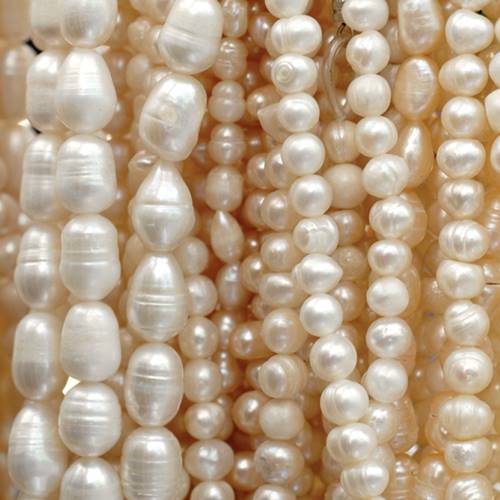|
Gemstones
Articles from PEARLS - LOOSE FRESHWATER (41 Articles), PEARLS - LOOSE / TEMPORARILY STRUNG (37 Articles)

Chinese have been improving their methods for growing cultured pearls.
Advances in Chinese freshwater pearls
Posted May 28, 2013 |
China has made many advances in technology across numerous fields and
over the past 800 years or so the Chinese have been improving their
methods for growing cultured pearls.
The early pearls were called blister or mabe pearls. In this process, an object is affixed to the inside of a mussel or oyster shell. This acts as an irritant to the animal, which covers the object with layers of nacre. The resulting pearl is then cut away from the shell.
The cockscomb mussel that produced the irregular, or “Rice Krispie”, fresh water pearl has been replaced by the Triangle mussel (Hyriopis cumingii), enabling the Chinese farmers to culture freshwater pearls of much larger sizes and quality.
In the past five years, the Chinese have imported Japan’s Biwa pearl mussel (Hyriopsis schlegeli) because they have found these have better vitality and produce better quality pearls.
From at least 2007, the Chinese have bred a hybrid of the Triangle and the Biwa mussels to produce nucleated fresh water pearls.
Some people in the trade have called them “fireball” pearls, because they have a tailed shape that makes them look like a comet. They have also been termed coin-bead/spherical bead or CBSB for short.
The reason for the tail is in the culturing insertion technique. However, the Chinese growers are working to create round pearls of 15mm and greater.
The growers are also nucleating mussels with their own tissue to culture freshwater pearls. They can also reshape the freshwater pearl nucleus to give an even higher proportion of round pearls. The natural nuclei makes identification of these pearls difficult, even with x-ray examination.
The quality of the freshwater pearls has also improved with fewer pearls being grown in each mussel. With the tissue-nucleated pearls, up to 50 could be grown in one mussel. However, the bead-nucleated mussels may have only five pearls growing in them, thus reducing the stress on the mussel and enabling larger pearls to be grown.
The pearl growth period is up to two years. After harvesting the pearl, the farmers put the mussel back into the water without further intervention, allowing a “keshi” type pearl to grow in the pearl sac.
Gathering information on pearl cultivation in China is difficult as the cultivators are highly secretive about their methods and research.
However, we do know that some are treating these pearls by dyeing, bleaching, heating, waxing, filling, coating or irradiation.
Low grade pearls are often dyed to improve their appearance. Traditional colours for Chinese fresh water pearls are white to cream, with pastel colours ranging from pink to apricot and lavender.
Irradiating gives pearls a high, almost iridescent artificial-looking lustre, and usually darkens the natural colour of the pearl. Coating is not widely used.
Another treatment used is called maeshori. In Japan, this “before treatment” was developed for use on traditional Japanese akoya cultured pearls. The treatment has expanded to include several newer techniques to enhance lustre and is being used on freshwater pearls, but they are not permanent and the enhanced lustre can fade from six months.
As with all gems, disclosure of treatments is essential. However many of the people selling these pearls have very little gemmological training and would not be able to identify the treatments if not disclosed to them.
Thus, pearls incorrectly described as untreated are passed down the chain to the consumer.
Given the very large range of treatments, and their prevalence, it is safer to assume that freshwater pearls have been treated in
some way.
|
|
|
|